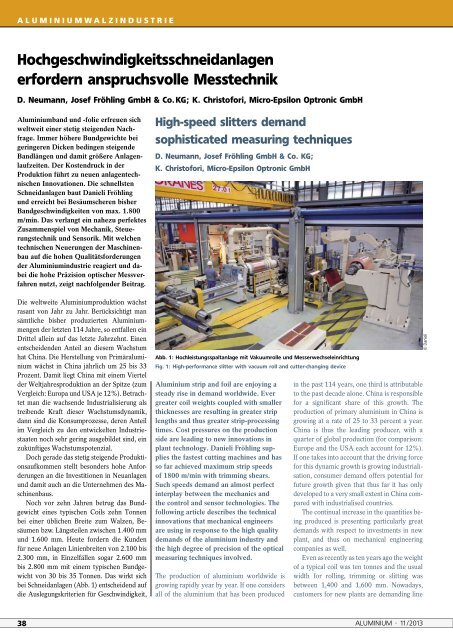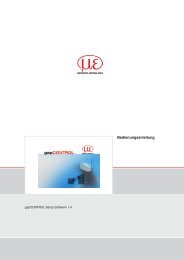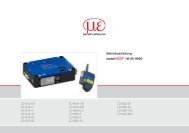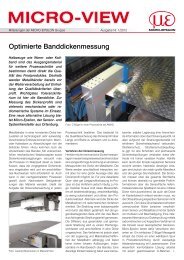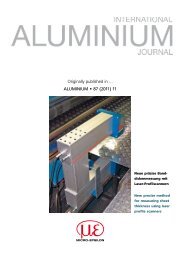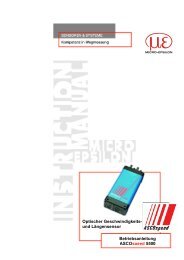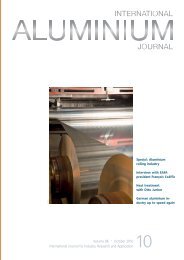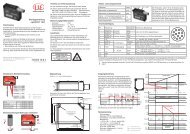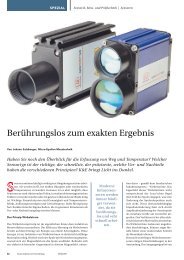Hochgeschwindigkeitsschneidanlagen erfordern anspruchsvolle ...
Hochgeschwindigkeitsschneidanlagen erfordern anspruchsvolle ...
Hochgeschwindigkeitsschneidanlagen erfordern anspruchsvolle ...
Sie wollen auch ein ePaper? Erhöhen Sie die Reichweite Ihrer Titel.
YUMPU macht aus Druck-PDFs automatisch weboptimierte ePaper, die Google liebt.
A L U M I N I U M w a l z I N D U S T R i e<br />
<strong>Hochgeschwindigkeitsschneidanlagen</strong><br />
<strong>erfordern</strong> <strong>anspruchsvolle</strong> Messtechnik<br />
D. Neumann, Josef Fröhling GmbH & Co. KG; K. Christofori, Micro-Epsilon Optronic GmbH<br />
Aluminiumband und -folie erfreuen sich<br />
weltweit einer stetig steigenden Nachfrage.<br />
Immer höhere Bundgewichte bei<br />
geringeren Dicken bedingen steigende<br />
Bandlängen und damit größere Anlagenlaufzeiten.<br />
Der Kostendruck in der<br />
Produktion führt zu neuen anlagentechnischen<br />
Innovationen. Die schnellsten<br />
Schneidanlagen baut Danieli Fröhling<br />
und erreicht bei Besäumscheren bisher<br />
Bandgeschwindigkeiten von max. 1.800<br />
m/min. Das verlangt ein nahezu perfektes<br />
Zusammenspiel von Mechanik, Steuerungstechnik<br />
und Sensorik. Mit welchen<br />
technischen Neuerungen der Maschinenbau<br />
auf die hohen Qualitätsforderungen<br />
der Aluminiumindustrie reagiert und dabei<br />
die hohe Präzision optischer Messverfahren<br />
nutzt, zeigt nachfolgender Beitrag.<br />
High-speed slitters demand<br />
sophisticated measuring techniques<br />
D. Neumann, Josef Fröhling GmbH & Co. KG;<br />
K. Christofori, Micro-Epsilon Optronic GmbH<br />
Die weltweite Aluminiumproduktion wächst<br />
rasant von Jahr zu Jahr. Berücksichtigt man<br />
sämtliche bisher produzierten Aluminiummengen<br />
der letzten 114 Jahre, so entfallen ein<br />
Drittel allein auf das letzte Jahrzehnt. Einen<br />
entscheidenden Anteil an diesem Wachstum<br />
hat China. Die Herstellung von Primäraluminium<br />
wächst in China jährlich um 25 bis 33<br />
Prozent. Damit liegt China mit einem Viertel<br />
der Weltjahresproduktion an der Spitze (zum<br />
Vergleich: Europa und USA je 12%). Betrachtet<br />
man die wachsende Industrialisierung als<br />
treibende Kraft dieser Wachstumsdynamik,<br />
dann sind die Konsumprozesse, deren Anteil<br />
im Vergleich zu den entwickelten Industriestaaten<br />
noch sehr gering ausgebildet sind, ein<br />
zukünftiges Wachstumspotenzial.<br />
Doch gerade das stetig steigende Produktionsaufkommen<br />
stellt besonders hohe Anforderungen<br />
an die Investitionen in Neuanlagen<br />
und damit auch an die Unternehmen des Maschinenbaus.<br />
Noch vor zehn Jahren betrug das Bundgewicht<br />
eines typischen Coils zehn Tonnen<br />
bei einer üblichen Breite zum Walzen, Besäumen<br />
bzw. Längsteilen zwischen 1.400 mm<br />
und 1.600 mm. Heute fordern die Kunden<br />
für neue Anlagen Linienbreiten von 2.100 bis<br />
2.300 mm, in Einzelfällen sogar 2.600 mm<br />
bis 2.800 mm mit einem typischen Bundgewicht<br />
von 30 bis 35 Tonnen. Das wirkt sich<br />
bei Schneidanlagen (Abb. 1) entscheidend auf<br />
die Auslegungskriterien für Geschwindigkeit,<br />
Abb. 1: Hochleistungsspaltanlage mit Vakuumrolle und Messerwechseleinrichtung<br />
Fig. 1: High-performance slitter with vacuum roll and cutter-changing device<br />
Aluminium strip and foil are enjoying a<br />
steady rise in demand worldwide. Ever<br />
greater coil weights coupled with smaller<br />
thicknesses are resulting in greater strip<br />
lengths and thus greater strip-processing<br />
times. Cost pressures on the production<br />
side are leading to new innovations in<br />
plant technology. Danieli Fröhling supplies<br />
the fastest cutting machines and has<br />
so far achieved maximum strip speeds<br />
of 1800 m/min with trimming shears.<br />
Such speeds demand an almost perfect<br />
interplay between the mechanics and<br />
the control and sensor technologies. The<br />
following article describes the technical<br />
innovations that mechanical engineers<br />
are using in response to the high quality<br />
demands of the aluminium industry and<br />
the high degree of precision of the optical<br />
measuring techniques involved.<br />
The production of aluminium worldwide is<br />
growing rapidly year by year. If one considers<br />
all of the aluminium that has been produced<br />
in the past 114 years, one third is attributable<br />
to the past decade alone. China is responsible<br />
for a significant share of this growth. The<br />
production of primary aluminium in China is<br />
growing at a rate of 25 to 33 percent a year.<br />
China is thus the leading producer, with a<br />
quarter of global production (for comparison:<br />
Europe and the USA each account for 12%).<br />
If one takes into account that the driving force<br />
for this dynamic growth is growing industrialisation,<br />
consumer demand offers potential for<br />
future growth given that thus far it has only<br />
developed to a very small extent in China compared<br />
with industrialised countries.<br />
The continual increase in the quantities being<br />
produced is presenting particularly great<br />
demands with respect to investments in new<br />
plant, and thus on mechanical engineering<br />
companies as well.<br />
Even as recently as ten years ago the weight<br />
of a typical coil was ten tonnes and the usual<br />
width for rolling, trimming or slitting was<br />
between 1,400 and 1,600 mm. Nowadays,<br />
customers for new plants are demanding line<br />
© Danieli<br />
38 ALUMINIUM · 11/2013


